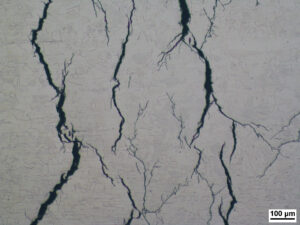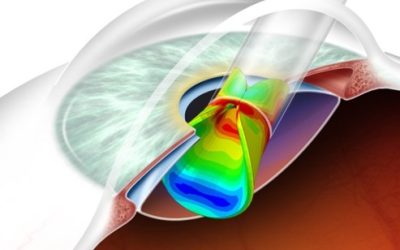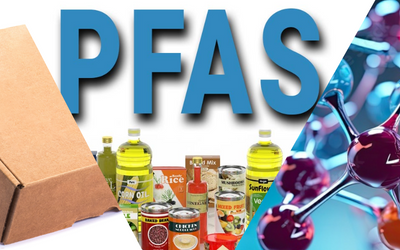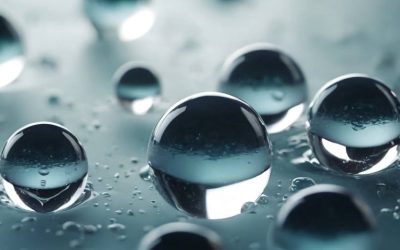THE CHALLENGE
Cracks are a common form of damage that affects equipment such as spray dryers, heat exchangers, and retorts used in the food processing industry. This equipment is used to produce a range of products including baby formula, sauces, and canned tuna.
Cracks are dangerous for several reasons. First, cracks reduce the structural integrity of equipment and reduce the operational loads that the equipment can withstand before catastrophic failure occurs. Second, cracks are an area for potential incubation and growth of bacteria that can contaminate the process. Finally, chemicals used during cleaning may wick into cracks and then later leach out during operation resulting in contamination of the process.
 Cracks can develop as a result of stresses experienced by the equipment during operation—induced either by thermal or mechanical loading—or by the combined interactions of the material, environment, and stress. It is this latter form of cracking—often called environmental cracking or stress corrosion cracking—that is the focus of this article.
Cracks can develop as a result of stresses experienced by the equipment during operation—induced either by thermal or mechanical loading—or by the combined interactions of the material, environment, and stress. It is this latter form of cracking—often called environmental cracking or stress corrosion cracking—that is the focus of this article.
THE PROBLEM
Stress corrosion cracking, or SCC, describes a type of crack formation that results from the combined presence of (a) a susceptible material; (b) a tensile stress; and (c) an aqueous environment containing a corrosive species that could induce cracking in the material. Welded Type 300-series stainless steel—a common material family used in the food processing industry—is particularly susceptible to SCC in aqueous solutions containing either caustic or chlorides (that is, salt). Tensile residual stresses from welding are often the primary stress driver for SCC of food processing equipment. Fluctuating stresses from temperature swings or other sources (for example, vibratory hammers) typically act as a secondary driver in superposition with residual stresses that result from welding. Furthermore, both caustic and chloride-containing environments may be present either during the clean-in-place (CIP) processes—often in the form of caustic cleaning agents or by the use of untreated water—or in the process itself because of the heavily salt-laden food products. Even if the concentration of corrosive species is low, evaporation during a dryout cycle can concentrate the corrosive species as dryout progresses and SCC has been reported at nominal chloride concentrations as low as 0.5 ppm when local concentration mechanisms are present. As a result, the combination of higher temperatures and increased concentration of the corrosive species can increase the risk of developing SCC as dryout progresses even if the risk is initially low. Finally, aging equipment can be particularly vulnerable as process conditions may have evolved over the 50+ year lifespan of the equipment and the incumbent materials may no longer be suitable for the more aggressive environments used today.
THE SOLUTION
As stated previously, SCC results from the combined presence of a susceptible material, a tensile stress component, and a suitable environment. Removing one or more of the three factors will eliminate the risk of cracking and mitigation strategies reflect this fact. As a result, strategies include material substitution, a change in environment, or a reduction in the component of tensile stress through surface stress relief treatments.
These strategies are intended to eliminate or mitigate the occurrence of SCC (that is, the presence of cracks in food-contact surfaces) and to support increasing uptime by reducing the inspection frequency or decreasing the length of any inspections that are performed.
In general, all Type 300-series steels are highly susceptible to SCC in caustic and chloride environments. Often, the simplest—in theory—solution to mitigate SCC is to replace the susceptible material with a more SCC resistant alloy. Material replacement is typically restricted to new construction equipment.
Alloys with good resistance against caustic SCC do not necessarily exhibit good resistance against chloride SCC. In general, the resistance to SCC tends to increase as the nickel, molybdenum, and chromium content of the alloy increases. Common replacement materials that can be considered include superaustenitic stainless steels (for example, Alloy Al6XN) and nickel-iron-chromium alloys (for example, Alloy 28). Equipment constructed from these alloys do not require any post-weld heat treatment or stress relief operations if appropriate weld procedures and filler metals are used. However, it is recommended that any heat tint is removed after welding for maximum corrosion resistance. The final material selection will require a balance of cost, material availability, ease of manufacture, and acceptable corrosion resistance to the process.
Alternatively, equipment manufactured from Type 300-series stainless steel could also be considered if appropriate stress relief is performed. Because welded Type 300-series stainless steels are susceptible to both caustic and chloride SCC, welds must be subjected to some treatment that reduces the magnitude of tensile residual stresses present at the welds. Tensile residual stresses can be reduced by thermal stress relief or by mechanical methods that produce localized plastic deformation.
Type 300-series stainless steels typically require heating to temperatures of approximately 1000 °F for thermal stress relief. As a result, small structures or components are most amenable to thermal stress relief methods and the size of some pieces of food processing equipment prevents consideration of thermal stress relief.
Instead of thermal stress relief, several technologies exist to use localized plastic deformation to reduce tensile residual stresses. These technologies include shot peening, laser peening, vibratory peening, low plasticity burnishing, and autofrettage. The exact technology that can be used depends on the geometry and size of the equipment. In general, these technologies induce localized plastic deformation in the material to change the residual stress state from tension to compression. The depth of stress relief below the surface varies between techniques and laser peening and low plasticity burnishing tend to produce a deeper layer of compressive residual stresses compared to the other techniques. Regardless of the technology used, the level of stress relief and effect on SCC resistance should be confirmed by laboratory testing, particularly when developing novel applications of these techniques to large pieces of equipment.
While stress relief treatment is effective at preventing SCC from occurring in equipment made from susceptible materials, it is our opinion that a material-based solution—rather than a process-based solution—confers greater security against SCC in new-construction equipment. In particular, it is relatively easy to perform a surface treatment on equipment manufactured from susceptible materials at the point of manufacture (that is, before being placed in operation). However, if any future welding is performed on the equipment (for example, repair or modification), then surface treatment may be prohibitive (for example, as a result of cost or timing) at that time. Equipment manufactured from SCC-resistant materials would not be subjected to such surface treatment requirements after any future repair or modification.
Surface stress relief may also be considered for existing equipment manufactured from susceptible materials that have already experienced SCC. Typically, such approach requires a combination of (a) thorough inspection of the welds and subsequent repair of cracks by certified personnel; (b) imparting compressive residual stresses on the food-contact surface of the equipment; and (c) review of the current CIP process and environment to determine if the cleaning process can be made less severe to reduce the risk of cracking while meeting any requirements for cleanliness and safety.
Finally, modifications to the water quality and the CIP process should be evaluated to reduce the severity of the environment. If practical and economical, then deionized, deaerated water should be used to reduce any risk of chloride-induced SCC. CIP process changes may include a reduction of caustic concentration, wash temperatures, and wash times. Note that modified CIP processes must still meet any requirements for cleanliness and safety. Small amounts of inhibiting chemicals, or inhibitors, can also be added to the water used during CIP cleaning to further reduce the risk of SCC. If used, inhibitors should be continuously injected into the water during CIP cleaning; any inhibitors should be verified to be safe for use on food contact surfaces before use.
For any solution, SCC should be evaluated in the laboratory using the same chemical environments that are experienced in the actual process or operation. Typically, the objective of these laboratory studies is to reduce the risk of SCC by establishing limits on the maximum allowable tensile stress, reducing the severity of the operating environment, and evaluating the effectiveness of surface treatments that reduce residual tensile stresses. These investigations can be aided by computer simulations that calculate the stresses in the equipment that may result from operation, thermal cycling, and other sources. Once these solutions are verified, they can be transferred to the food processing equipment.
Force-4 — Smart Ideas for A Smart World. We are a force for innovation because we envision and translate brilliant ideas into highly experiential and efficient products. Our expert team of strategists, industrial designers, and engineers unlock new ideas while navigating complex technical challenges to take your product to market faster.
Stress Engineering Services — Innovative Solutions for Cutting Edge Ideas. Our passionate, multidisciplinary team of expert problem-solvers believes that the future of innovation requires forward-thinking solutions and a tenacious commitment to cutting-edge ideas. Therefore, we commit to providing the most comprehensive design, analysis, and testing services with unsurpassed engineering integrity and expertise.
SES Force-4 is a forward-thinking expert team with in-depth technical knowledge, proven device development, and automation solutions.
AUTHOR

Dr. Erik Pavlina, Senior Associate, specializes in the processing and manufacturing of metals, materials selection, and failure analysis. He has extensive experience in manufacturing, industrial R&D and product development, and fundamental research in ferrous and non-ferrous alloys. Erik undoubtedly understands the challenges facing the production and application of materials to ever-increasing performance requirements. He has constantly strived to work on diverse teams to bridge the gap between materials and mechanical engineering to provide effective solutions.
Reference: C008-CP Plastic Cracking in the Food Industry
Keep in touch with us.
Sign up for our newsletter.



